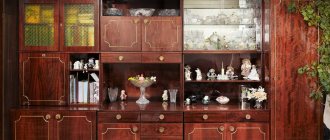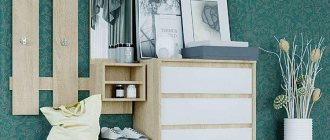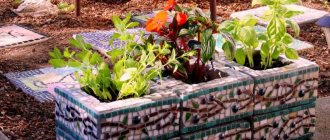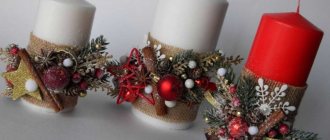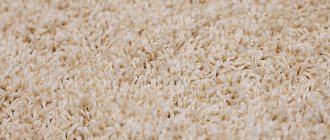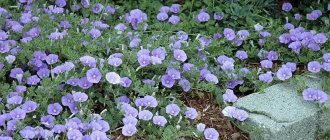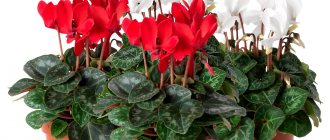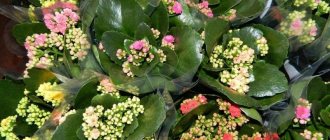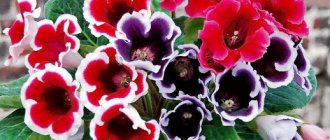Ideas for using hedges
Landscape designers use green spaces as low borders. It emphasizes the curves of paths and architectural objects, flower beds and fountains. Living decoration is also suitable for decorating a pond or playground. What is the best hedge to use as a border:
- cowberry;
- Thunberg barberry;
- boxwood;
- Lawson cypress;
- dwarf caragana.
A “border” of plants.
On a large area, plantings can be used to zone the space. Separate the recreation area from the garden or vegetable garden. Designers advise choosing shrubs with a height of up to a meter. This will avoid creating unnecessary shadow. Planted in parallel, symmetrically, wavy.
Standard rectangular shapes surprise no one. Shrubs for hedges can take a variety of shapes. Even a novice gardener can do cubes, arches, waves. Masters of their craft embody images of animals using garden shears. Such compositions require frequent maintenance.
Designer flower beds
Using plantings as a design accent is a great option. Colorful multi-level structures transform any area. Red-leaved boxwood and blue spruce are often combined. To maintain an attractive appearance, experts recommend choosing perennial plants of a contrasting shade.
If the area looks bland, then it is good to use flowering plants. Spiraea, currant and hawthorn bloom from several weeks to a month. By combining large plants with low borders, you can get compositions that bloom all year round.
Properly selected plants are the key to beautiful flower beds all year round
Eclecticism is trending not only on fashion catwalks. Hedging bushes are combined not only with sculptural compositions. The following solutions also apply:
- gabions;
- large stones;
- boulders;
- fences;
- wooden modules;
- brick pillars.
Green plants will help “restore” an old fence. Climbing or tall plants are useful for this purpose. The wire structure will allow you to create a hedge of clematis, hydrangea, honeysuckle, grapes and wisteria. Climbing roses are especially beautiful.
Path of roses
See also: Catalog of companies that specialize in landscaping work on sites.
TOP fast-growing shrubs for creating a hedge
In landscape design, a “fence” of green spaces is usually divided into two types: formalized and unformed. The latter is used extremely rarely, as it gives the site a neglected appearance. Fast-growing hedge shrubs will transform your landscape in a short time.
- Dogwood , with proper care, reaches 3-4 meters in height. It blooms from March to April, then blooms leaves and fruits. A well-lit area is suitable for growing. When buying an annual plant, you need to understand that dogwood grows slowly, and a two-year-old seedling grows more actively.
Dogwood hedge
- The bladderwort is unpretentious in care. It is important that the water at the roots does not stagnate, otherwise the plant will die. It reaches four meters in height, but dwarf shrubs up to a meter are suitable for creating a neat hedge. Over the course of a year, he gains 35-38 cm in height. Maintains an attractive appearance throughout the season.
Bladderwort hedge
- Snowberry belongs to the genus Honeysuckle. Bluish-green leaves, white flowers with a pink tint are complemented by berries. The hedge looks very unusual and elegant. This shrub is suitable for plantings no more than 125-130 cm in height.
Advice! The snowberry is unsuitable for a formalized hedge with clear edges. For this purpose it is better to choose another option.
- Hawthorn is simply created for a hedge. It grows quickly, lives for three hundred years and is unpretentious to living conditions. At the gardener’s request, you can create either a sparse “wall” or a dense dense hedge. Designers advise planting exclusively in a checkerboard pattern.
Hawthorn hedge
Only three-year-old plants are suitable for planting. Two years after planting, the bush is heavily pruned, leaving 20 cm branches. This will lead to an increase in the density of the future hedge.
General planting standards
Disembarkation process
When choosing planting material, you need to take into account that the young shoots purchased are of the same age:
- deciduous – 2-3 years
- coniferous – 3-6 years
This is the most suitable age for good adaptation and adaptation to a new environment.
When forming a fence located in the shade, it is necessary to choose older seedlings (7-8 years old), because such conditions are unfavorable for their normal growth. Already large plants will be able to create some colorful appearance.
Seedlings are usually planted in the middle of spring, although for the southern regions planting in the autumn season is possible.
Hedge trimming
Work process:
1Begin work by marking out the shape of the future planting. It must retreat from an existing fence or other structure by at least 0.5 m
2Then dig a ditch (0.5-0.6 m), into which a suitable substrate and fertilizer are poured
3The planting material is laid out maintaining the required intervals between each other. The rhizomes unfold before planting
4The root system of deciduous trees is pre-soaked in water for several hours, and before planting it is treated with a mixture consisting of organic fertilizer and clay.
5For better survival rate, it is recommended to leave the earthen ball in which the seedling is planted
6Large shrub plants are arranged in 1 row, and small ones - in 2, in a checkerboard arrangement
It is better to land along a stretched rope.
7Next, the seedlings are covered. The soil needs to be compacted
Hedge
When purchasing, be sure to specify how exactly the material should be planted - buried or elevated.
8The planted plant is watered 2-3 times and covered around with mulching material to retain moisture
During the first year, the greens must be watered regularly, the soil underneath must be loosened, weeds removed, and fertilized periodically. In autumn, pruning is mandatory, even for free-growing plants.
TOP evergreen shrubs for hedges
If you need a fast-growing perennial evergreen hedge, then thuja is an ideal option. There are more than a hundred different species, among which are smaragd and brabant .
Annual growth is up to 30 cm. You can create a rarer evergreen “fence” or a dense one. In the latter case, thuja is planted every 50cm.
Dense fence made of thuja
Boxwood grows more slowly, barely reaching 20 cm annually. But gardeners love the plant for its ease of care and resistance to different weather conditions. The plant allows you to create a dense hedge up to a meter high.
Advice! The plant is thermophilic. Before the onset of frost, it should be covered.
Juniper is a favorite of landscape designers. The plant likes to be in the shade and is resistant to frost and precipitation. A fast-growing perennial juniper hedge does not require frequent watering. Planted at a distance of 60 cm. Spreading varieties are preferable for decorating borders.
Juniper hedge
Privet is considered an evergreen plant suitable for creating a hedge . Glossy elongated leaves with snow-white flowers. Closer to autumn, small berries of a characteristic blue color appear. For a decorated green “fence” it is suitable only with regular pruning over a long period of time. More often used for the unformed version.
Privet does not like careful design
Yew is a berry version of pine needles. It is odorless due to the absence of emitted resin. Suitable in landscape design for creating hedges. It differs in that:
- easy to care for;
- holds its shape for a long time;
- withstands heavy pruning;
- Any shape can be realized from it.
A hedge made of yew bushes is suitable for decorating a summer cottage and the territory of a hotel, restaurant, or park. Low and dense green “walls” look neat and tidy. A strong root system does not require frequent loosening of the soil and special fertilizers. Resistant to temperature changes. Yew does not grow as fast as other conifers. But the shape lasts for a very long time.
Yew hedge
Possible problems
Good care will contribute to a quick recovery if an unpleasant situation does occur.
At any stage of development with a living fence, the following unpleasant situations may arise:
- Fungal infection. During the treatment process, all branches that have grown over the year are cut off.
- Insufficient light. To do this, the fence is given a different shape, preferably in the form of a trapezoid.
- Disease of all plants. Everything is cut down to the very root system. This will disfigure the fence, but will allow the greenery to recover more quickly. It will be much faster than planting and growing a new living fence
To avoid further spread of the disease, the affected branches are immediately burned after pruning.
To treat fungal diseases and to control pests, there are special means that can be used to avoid pruning. And in order for the hedge to recover faster, it needs to have good watering and fertilization.
How nice it is to feel like a creator
When starting to create a living fence, everyone can feel like a creator . You can create a unique picture yourself. Of course, if you follow all the recommendations.
On a summer cottage intended only for summer recreation, it is better to grow flowering fences. And the presence of evergreens in the living wall will make it possible to admire the living wall in winter.
Shrubs that do not require regular trimming
It is convenient to use plants that do not need to be constantly trimmed to maintain an attractive shape. What is the best material to make a hedge from:
- kalmia;
- Spiraea Wangutta;
- caragana bush.
Kalmia bushes take root in loose soil. The plant cannot be called unpretentious. If water stagnates, the root system will quickly rot. Does not grow more than one and a half meters. The evergreen plant is distinguished by its unusual bright flowering in late spring.
Spiraea Vangutta is a large plant. Requires a lot of space, and therefore is not suitable for a small area. Beautiful bluish leaves, white flowers. The crown grows up to two meters in diameter.
Hedge Spirea Vangutta
Shrubby caragana takes root in areas with uneven surfaces. Differs in the shape of the leaves. The golden-hued flowers highlight the deep green of the foliage. It is easy to care for; caragana is resistant to temperature changes and tolerates heat and frost.
A bright yellow hedge will be made from forsythia . An amazing plant, which is one of the first to become covered with inflorescences and pleases its owners for more than a month. It consists of thin branches that allow you to give the bush any shape. A sunny, draft-free place is suitable for planting. You will have to wrap the plant in winter and provide plenty of watering in summer. The shrub is capricious to temperature changes.
Severe frosts will destroy the plant, and it will be impossible to restore the fence. Fertilize with mineral fertilizers in early or mid-spring, and add organic mixtures in the fall. Haircuts are done rarely and carefully. If you cut off all the sprouts that appear, the forsythia may not bloom in the spring.
Advice! It is better to trim forsythia after the end of the flowering period.
"Wall" of forsythia
The benefits of green space
A fast-growing hedge gives the area a neat appearance. But aesthetics is not the only advantage. Rich green shades, a pleasant aroma of greenery, the beauty of flowering and shade are an excellent help for plastic and metal structures. In addition, this is an environmentally friendly way to delimit the site.
A wide range allows you to choose any type of plant. They can be used alone or combined with structures, architectural elements, and other colors.
Hedges can be formed into various shapes
Introduction
Beautiful decor
A fence made of living greenery is one of the best ways to fence off an area. With good organization and well-groomed appearance, it can decorate a garden plot, does not require painting, is variable in height, and can last a long time.
With the help of such landscaping, you can decorate outbuildings, divide the site into zones, and a front garden decorated on the outside with a green wall will protect the residential building from scorching sun rays, wind, extraneous sounds from the street, dust, and fire.
Disadvantages of green “fencing”
Despite their unpretentiousness, plants can be susceptible to diseases. Then the aesthetics are completely lost. Improper care or untimely pruning also spoils the appearance. A hedge requires fertilizing, loosening the soil, and watering.
The type of plant will determine the frequency of pruning. Care is selected individually. Not every amateur gardener will agree to spend time maintaining the aesthetic appearance of a green “fence.”
Some types of haircuts are quite difficult to maintain in their original form.
Landing distances
Hedge
| Type of fencing | Row spacing, m | Spacing between rows, m |
| High cropped (2-6 m) | 0,8-1,2 | 1 |
| Tall, with free growth (2-6 m) | 1-2 | 2-3 |
| Medium cropped (0.6-1.5 m) | 0,4-0,6 | 0,8-1 |
| Medium, with free development (0.6-1.5 m) | 0,8-1 | 1-1,5 |
How to create fences from green spaces
The landscape designer communicates with the client and helps select plants. After consultation, a project and an exact drawing are drawn up. It is indicated in advance what types of plants will be placed and in what part of the site. A competent specialist will also indicate possible growth.
Plants for hedges are planted in prepared holes and trenches. The number of rows and bushes is calculated in advance. The soil is changed to a nutrient composition that is suitable for the selected plant. The specialist gives instructions for care and subsequent pruning.
To make the hedge look geometrically correct, careful preliminary calculations are required
Creating a hedge from climbing plants
Flowering climbing plants create amazingly beautiful hedges. Use a fence or stretch a mesh as a support. When forming, take into account the method of garter:
- vertical will increase the number of shoots;
- horizontal will increase height gain.
Seedlings are planted in the fall, closer to mid-October, but the creative process of forming a hedge can only begin after two years. Climbing roses are suitable for a luxurious hedge. The only negative is impassability (due to the density of the bushes and the presence of thorns).
Luxurious arches of roses
Possible disadvantages
It will take more than one year to grow
The main disadvantage is the long time it takes to grow shrubs or trees. You can, of course, if funds allow, purchase and plant adult planting material, but with a small budget you will need to be patient and wait for the plants to grow and form a dense and full-fledged hedge.
When choosing fruit bushes or trees for a partition, you need to prepare not only for a good harvest, but also for the contamination of paths and lawn areas with gifts that will be showered.
How to preserve the beauty of green spaces
Hedge bushes grow quickly and require careful attention. It doesn’t matter whether plantings are used for zoning space or simply as a decorative element, it is necessary to provide them with regular care.
Haircut is the main element of maintaining the attractiveness of a green “fence”. Prune more often at the end of June after the completion of the active growth stage. Fast-growing privet and similar plants are trimmed again in September.
Advice! Cypress and thuja will not withstand rare pruning. If you prune too infrequently, the heavily cut areas will not recover. Old branches will not produce new shoots. The fence will be hopelessly damaged.
Proper trimming is the key to long-term hedge service.
Experts advise preserving and maintaining the trapezoidal shape of the bushes so that the lower branches receive enough light. Boxwood, yew and other plants that can actively grow in the shade can be trimmed in a rectangular shape.
Spreading shrubs retain their rounded shape well. The upper part is narrower than the lower part. Sun-loving plant species require sufficient sunlight to maintain an attractive appearance.
The plant fence should receive enough sunlight

